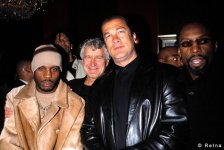Hi Glen,
In the opening I wrote "empirical results", means measured in vivo/circuit. The measurements for ECL82/PCL82 SRPP (open and closed loop) were done using this circuit, using a similar one with accordingly adjusted parts values for the ECL85 trioded SRPP measurements.
That was my point for the hint - the load considered to be ideal (f.e regarding max. Po) changes, since applied (g)NFB changes the effective plate resistance. Obviously doesn´t apply for a zNFB amp, though.
Regards,
Tom
Also, I’m not sure what you mean by “Note shifting of optimum reflected load value when gNFB is applied ”
How was the gNFB applied for those calculations?
In the opening I wrote "empirical results", means measured in vivo/circuit. The measurements for ECL82/PCL82 SRPP (open and closed loop) were done using this circuit, using a similar one with accordingly adjusted parts values for the ECL85 trioded SRPP measurements.
Applying global negative feedback, say from the speaker output to the cathode of a valve driving the SRPP output stage will lower the amplifiers output impedance and improve the damping factor,
That was my point for the hint - the load considered to be ideal (f.e regarding max. Po) changes, since applied (g)NFB changes the effective plate resistance. Obviously doesn´t apply for a zNFB amp, though.
Regards,
Tom
Tubes4e4 said:That was my point for the hint - the load considered to be ideal (f.e regarding max. Po) changes, since applied (g)NFB changes the effective plate resistance. Obviously doesn´t apply for a zNFB amp, though.
Hi Tom.
I'm not sure how to explain your tabulated results, but I think to say that global negative feedback changes (lowers) the effective plate resistance is a bit of an over simplification of how negative feedback improves the amplifiers damping factor. Global negative feedback does not change the internal characteristics of the output valves, and it is these internal characteristics which dictate the optimal load impedance for the output valves - an impedance whose relation remains dictated by the SRPP formula: Rcathode=1/gm+(2Rload/u), regardless of whether or not the SRPP output stage is enclosed within a global negative feedback loop or not.
Cheers,
Glen
Hi jeapel,
Different from circuit shown, a 1,5uF input cap and a 330k grid leak resistor was used for the following plot:
10kHz, 1V/DIV = 4Vpp, into 6 ohms (pure ohmic):
20 kHz square at secondary, closed loop (6 dB gNFB), 5 usec/div, 2V/div:
Pic 27: 20 kHz square at secondary, open loop (zNFB), 5 usec/div, 2V/div:
Now for complex loads.
Added 0,1µF across output to ohmic load. 10 kHz square at secondary, closed loop (6 dB gNFB), 10 usec/div, 2V/div:
Added 1µF across output to ohmic load. 10 kHz square at secondary, closed loop (6 dB gNFB), 10 usec/div, 2V/div:
No; 30VA or 33VA types are sufficient for the PCL82SRPP circuit as shown.
Regards,
Tom
-the frequency range is ?
Different from circuit shown, a 1,5uF input cap and a 330k grid leak resistor was used for the following plot:
An externally hosted image should be here but it was not working when we last tested it.
-the square wave test give ?
10kHz, 1V/DIV = 4Vpp, into 6 ohms (pure ohmic):
An externally hosted image should be here but it was not working when we last tested it.
20 kHz square at secondary, closed loop (6 dB gNFB), 5 usec/div, 2V/div:
An externally hosted image should be here but it was not working when we last tested it.
Pic 27: 20 kHz square at secondary, open loop (zNFB), 5 usec/div, 2V/div:
An externally hosted image should be here but it was not working when we last tested it.
Now for complex loads.
Added 0,1µF across output to ohmic load. 10 kHz square at secondary, closed loop (6 dB gNFB), 10 usec/div, 2V/div:
An externally hosted image should be here but it was not working when we last tested it.
Added 1µF across output to ohmic load. 10 kHz square at secondary, closed loop (6 dB gNFB), 10 usec/div, 2V/div:
An externally hosted image should be here but it was not working when we last tested it.
-any advantage to take 100va or 200va ?
No; 30VA or 33VA types are sufficient for the PCL82SRPP circuit as shown.
Regards,
Tom
Hi Glen,
I wholeheartily agree that it is an oversimplification, but it still is a plastic and helpful illustration for those who are not as good in theorectics and math as you are. (I mean this w/o any undertone (?) in any direction.)
Regards,
Tom
I'm not sure how to explain your tabulated results, but I think to say that global negative feedback changes (lowers) the effective plate resistance is a bit of an over simplification of how negative feedback improves the amplifiers damping factor.
I wholeheartily agree that it is an oversimplification, but it still is a plastic and helpful illustration for those who are not as good in theorectics and math as you are. (I mean this w/o any undertone (?) in any direction.)
Regards,
Tom
the_manta said:I wouldn't use an Aikido (oh how I hate this name) as output stage.
Best configuration is like the original Totem Pole Amplifier, with output at the Cathode.
Manta
Steven Seagal and his friends would rather object about hating Aikido as a name...

Attachments
Tweeker said:I'll take results in practice over theory any day.
Well any technique used to collect empirical data must be conducted in accordance with a concrete theoretical basis; lest the veracity of the data and the conclusions drawn from it frivolously lead us down the proverbial garden path.
That’s all I’m going to say on that topic

Incidentally, the development of my SRPP amp is coming along nicely – I’ll post the complete schematic set on the weekend.
Cheers,
Glen
- Status
- This old topic is closed. If you want to reopen this topic, contact a moderator using the "Report Post" button.
- Home
- Amplifiers
- Tubes / Valves
- 6B4G SRPP
